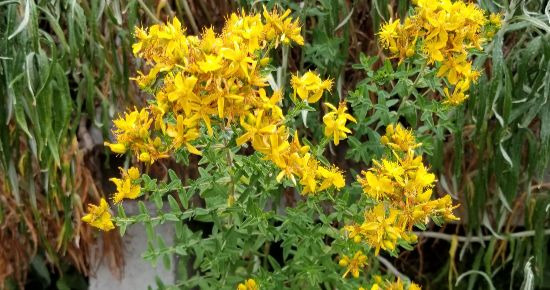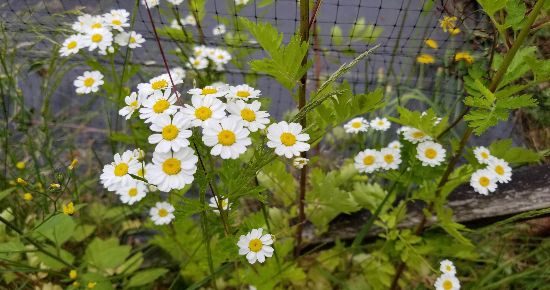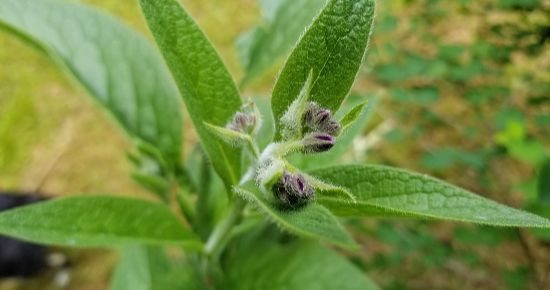St. John’s wort, feverfew and comfrey: this trio of herbs of the sun blooms at St. John’s Day. The Feast of St. John on June 24 is the Christian version of the midsummer holiday that Pagans and magicians celebrate. As a Pagan magician I know that herbs blooming during the summer solstice carry a lot of solar power.
This came up during a theurgy forum podcast last week when our host Hercules Invictus, guest Tony Mierzwicki and I discussed health care. The ancients were known to care for people as healers and advocates of social justice. Modern theurgists are concerned about equitable access to health care. In our own lives we also fall back on the natural remedies tested by the ancients. Theurgy teaches that the energies of the planets are found in stones, animals and plants. We leverage that knowledge to determine how the plant can be helpful in healing. Solar plants help with eyesight, depression, and general healing.
Disclaimer: information provided for educational purposes only. These herbs are powerful medications and should be used under medical supervision.
St. John’s Wort
Botanical name: Hypericum perforatum.
Bloom time: St. John’s wort blooms right on St. John’s day. You have to catch it quick because it only blooms for a week and all the plants bloom at once. It’s widespread throughout America and Europe and grows right along the roads and highways. I tried transplanting it once but it didn’t take in my garden, it prefers that weedy area right by the pavement.
Similar plants: in the Northwest the week of St. John’s wort bloom is followed immediately by successive blooms of tansy ragwort. They grow in exactly the same locations so you have to be able to recognize both! Plants with “wort” in their English names generally have been used as medicinal herbs, and both St. John’s wort and tansy ragwort are useful, but tansy is a noxious weed in Washington state because it makes animals ill. My county weed control officer sprays it so I don’t use it as an herb, instead I hand pull it and tell the officer so she can skip my road.
There’s also a landscape version of St. John’s wort that is actually used to illustrate articles about the plant. The flowers are much larger and bloom longer, but it does not have medicinal powers.
What it treats: St. John’s wort is used in small amounts to relieve depression. It is sometimes prescribed as a medication. It has the known side effect of making the eyes sensitive to the sun so it’s important to pay attention to that and talk to your doctor about it.
How to use: you can dry the flowers and make them into tea. You can also make a simple tincture by covering the fresh or dried flowers with high-proof alcohol (80% or more) like vodka or Everclear. Steep this for six weeks, then decant into dark bottles and keep in a dark cupboard. The tincture will keep for about seven years. In practice I try to renew my tinctures every two or three years to keep them fresh.
Feverfew
Botanical name: Tanacetum parthenium.
Bloom time: feverfew is an easy herb to grow in the garden, it grows to zone 5 in poor soil. It’s so easy to grow that mine is escaping and I have to chase it down and control it or my county weed control officer will be cross with me! It has a longer bloom than St. John’s wort. Individual plants can be cut and will bloom again, and successive waves of plants bloom throughout the summer.
Similar plants: feverfew looks something like chamomile. I grow this too and I drink a lot of chamomile tea for relaxing at night. Like feverfew it can escape the garden and naturalize so you have to keep your eye on it.
What it treats: This treats headache, especially migraine. When my migraine pills went up to $100 I started growing this herb!
How to use: unlike St. John’s wort you need to use feverfew daily to build up the effect. When it’s blooming I eat a flower or leaf on toast, which helps to cut the bitter taste. You can also make a tincture with the leaves and flowers and take a few drops under the tongue each day.
Comfrey
This is technically an herb of Saturn. I include it here because it blooms at the same time as St. John’s wort and feverfew, and because it is one of the most useful herbs in my medicine cabinet. I make sure to have dried comfrey leaves and flowers in my medicine cabinet and refresh them every year. It also needs full sun so I maintain that it does capture solar power!
Botanical name: Symphytum Officinale.
Bloom time: this herb blooms all summer long. Our county weed control officer comes tries to get the master gardeners not to sell it at our plant sales because it is starting to be a problem. I have personally promised her I will not let mine set seed! My grass cutters mow it down once a month and it comes back, so you can see it’s a hardy plant.
Similar plants: borage leaves resemble comfrey but they’re easy to tell apart when they’re blooming. Borage is also a medicinal herb and bees love it.
What it treats: it’s fantastic for healing skin problems.
How to use: I place the leaves between gauze sheets and wet them with hot water to make a poultice. I have used them on spider bites. I emphasize that spider bites are dangerous and I see a doctor right away whenever I get one! I tell them I am using comfrey poultices. They generally shrug and don’t object, and some have been impressed with the results.
This is the week to get out and collect St. John’s wort! While you’re out there you can pick the feverfew and comfrey if you have it. As a Pagan I thank the plant, and as a theurgist I give thanks to the sun for the virtues of the plants.







